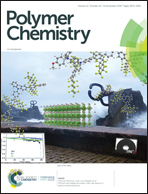A pillar[5]arene-based hydrogel adsorbent in aqueous environments for organic micropollutants†
Abstract
Adsorption and removal of organic micropollutants from aqueous environments has attracted lots of attention in global water treatment. As a kind of “smart” adsorbent, hydrogel is widely used in the field of wastewater treatment due to its convenient operability. In this study, we successfully utilized hydrazide-functionalized pillar[5]arene P5-1 and 4-aldehydephenyl-functionalized pillar[5]arene P5-2 to prepare a hydrogel, P5P5G, for the adsorption and removal of organic micropollutants from aqueous media. P5P5G is sturdy enough to exhibit robust operability in the adsorption experiment and can adsorb a variety of organic micropollutants from water with high removal efficiency. Kinetic and thermodynamic studies and NMR experiments imply that the adsorption is mainly driven by the host–guest interactions between the pillar[5]arene macrocycle and pollutant molecules. The guest recognition nature thus endows the pillararene with the ability to capture multiple types of pollutants, including cationic, anionic, and neutral molecules. As a result, our pillararene-based hydrogel can adsorb various kinds of pollutants with diverse characteristics and be easily regenerated by the decomposition of the host–guest complexation.
![Graphical abstract: A pillar[5]arene-based hydrogel adsorbent in aqueous environments for organic micropollutants](/en/Image/Get?imageInfo.ImageType=GA&imageInfo.ImageIdentifier.ManuscriptID=C9PY01373C&imageInfo.ImageIdentifier.Year=2019)
- This article is part of the themed collection: Polymer Chemistry Lectureship Winners


 Please wait while we load your content...
Please wait while we load your content...